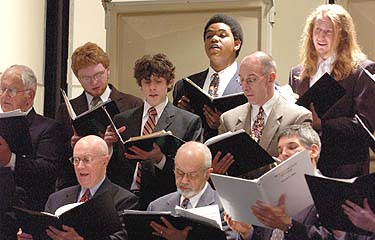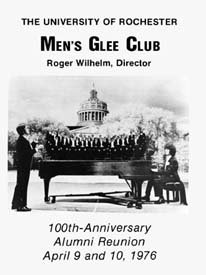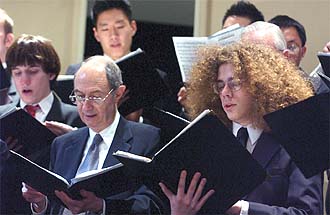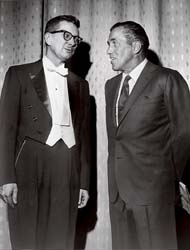

A Glee-ful Return
Alumni and students join together to re-establish the tradition of Rochester’s
Glee Clubs. By Jayne Denker
 |
| CELEBRATIONS: Alumni and community members join students onstage to mark the Glee Club’s 130th anniversary. One of the oldest clubs in the country, the ensemble celebrated 100 years in 1976. |
It’s less than six hours to show time and the 50 or so singers are hard at work in Strong Auditorium. With folders of sheet music held out in front of them like serving trays and with one eye on conductor L. Brett Scott, the men—a mix of young and old—earnestly rehearse a selection from Randall Thompson’s Testament of Freedom . . . till the baritones hit a clunker and falter. Everyone laughs.
“That’s all right,” says Scott, an assistant professor in the College’s Department of Music, “We’ll save the grandiose stuff for this afternoon.”
And the ensemble—the 2006 edition of the Men’s Glee Club and a contingent of alumni volunteers—takes it from the top, one more time.
The men are remarkably relaxed, considering they’re rehearsing together for the first time only hours before their concert to celebrate the 130th anniversary of the club’s founding. Then again, it’s not like they haven’t seen the music before.
“The songs are branded on our brains,” says Bob Hyman ’74.
Hyman and his friend of 30 years, Paul Tasca ’72, both of Rochester, have returned to campus for the March event. They’re two of 25 alumni who traveled down the street or halfway across the country—hometowns include Marietta, Georgia; Tucson, Arizona; and Racine, Wisconsin—to rejoin one of the oldest organizations on campus.
 |
Although inactive since the 1990s, the Men’s Glee Club dates to 1876 and ranks as one of the oldest clubs in the country. (Harvard’s was founded in 1858, Yale’s in 1863, and Princeton’s in 1874.) It also boasts a storied history. Before World War II, the club toured the country, performed on national radio programs, bested more than 140 other groups to win the Fred Waring National Glee Club competition, and performed for President Franklin Roosevelt.
In the 1950s and ’60s the ensemble—reinvigorated following an increased enrollment of male students after the war and guided by Ward Woodbury ’54E (PhD), who was the first director of music on the River Campus—reached the pinnacle of its popularity. The group performed on The Ed Sullivan Show and even serenaded a 4-year-old Caroline Kennedy with an impromptu performance of “Thank Heaven for Little Girls” on the White House lawn in 1960.
The men’s club celebrated its 100th anniversary in 1976 in high style, but interest in both the men’s and women’s groups began to dwindle in the subsequent decades and, in the 1990s, the ensembles were combined into the University Choir.
“These things have their cycles,” says Scott, who is credited with spearheading the drive to restart both groups. “Every Meliora Weekend I have alumni coming up to me, saying, ‘We sang in the Glee Clubs.’ It’s such a strong tie for alumni, such a strong sense of history.
 |
“I started looking through the archival material and began to realize the wonderful history of the Glee Clubs—the Women’s Glee Club as well, which will be celebrating its 95th anniversary soon—and I thought this would be a way to return to the history we have here . . . a way to regain a sense of pride and connection to the long, long history of singing on campus.”
Those onstage bring their own sense of tradition: Hyman’s eyes light up with mischief when he asks, “Did you hear we hijacked the song lineup?”
Scott, who didn’t know about the tradition of singing the “UR Medley” of University tunes and football fight songs that culminates in the singing of “The Genesee,” gamely added it to the song lineup at the last minute, with Hyman as accompanist.
In their new incarnations, the men’s and women’s clubs were reinstated last fall as vocal ensembles sponsored through the Department of Music. Students can join for course credit, and alumni—along with faculty, staff, and community members—are welcome as well. Scott plans to hold open auditions every semester.
The number of members in the men’s and women’s clubs each hovers
around two dozen apiece—figures fluctuate depending on how many students
are taking the class—and Scott says he expects membership to increase
as word gets out.
“I expect the new Glee Club to be the same as it
was in the past—like a big family.”—Stetmond Roberson ’09
While performing at the White House might be a little further in the future
for the ensemble, Scott is optimistic that it will become a favorite on campus
again.
“I get the sense that there was something lost and hopefully is coming
back,” he says. “You never know what the future will hold, but there’s
certainly strong support from the alumni and from the music department. Already
the number of members is greater than I expected.”
Stetmond Roberson ’09, a mechanical engineering major, says that participating in the club helps him balance his life on campus. “I can’t even express how big a part music plays in my life,” he says. “I expect the new Glee Club to be the same as it was in the past—like a big family.”
Between morning rehearsal and performance that spring afternoon, members past and present sit down to lunch and to share reminiscences—more than a few of the ribald sort—from the club’s heyday in the 1940s, ’50s, and ’60s.
Karl Nelson ’59 tells the tale of the tour bus getting stuck on a mountain pass in Colorado. “We counted—it made a 47-point turn,” says Nelson.
John Braund ’53 presents a document showing the actual budget for the 1953 Chicago tour: Each man’s allowance was $4.75 for all meals—plus tips.
Ron Gigliotti ’62 admits that their performance on The Ed Sullivan Show was taped. “After the performance, Ward Woodbury came out from behind a closed curtain to chat with Ed Sullivan, as if we were behind the curtain. But we were back at the hotel drinking and watching it on television.”
 |
| TRADITION: During this spring’s celebration, alumni reminisced about the Glee Club’s history, including a performance on The Ed Sullivan Show, where founding River Campus music director Ward Woodbury talked with the show’s host. |
Only time constraints prevent the alumni from telling stories for the rest of the afternoon. It’s time to go back to Strong Auditorium and rehearse for a few more minutes. But before getting back to business, Braund gives a heartfelt appeal to Scott and the undergraduates.
“Keep it going, please,” says Braund, the fondness for the club revealed in the ache in his voice. “You have an opportunity to make the Glee Club great again.”
Vicente Ditto ’06, a music major and the assistant conductor of the club, says, “You can tell the Glee Club means a great deal to alumni. I’m sincerely happy it’s been revived and we can continue the legacy the alumni have left us.”
When the alumni join the current Glee Club members onstage, the power of the tradition is clear.
With the ensemble’s numbers doubled for the second half of the concert, the older men buoy the younger, proudly and loudly sing the familiar songs, happy to take it from the top one more time.
Jayne Denker is associate editor of Rochester Review.
